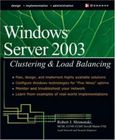Optimal Load Balancing in Distributed Computer Systems

Book Details:
| Publisher: | Springer |
| Series: | Springer |
| Author: | Hisao Kameda |
| Edition: | 1 |
| ISBN-10: | 3540761306 |
| ISBN-13: | 9783540761303 |
| Pages: | 251 |
| Published: | Jan 14 1997 |
| Posted: | Nov 19 2014 |
| Language: | English |
| Book format: | |
| Book size: | 9.04 MB |
Book Description:
An important consideration in improving the performance of a distributed computer system is the balancing of the load between the host computers. Load balancing may be either static or dynamic; static balancing strategies are generally based on information about the system's average behavior rather than its actual current state, while dynamic strategies react to the current state when making transfer decisions. Although it is often conjectured that dynamic load balancing outperforms static, careful investigation shows that this view is not always valid. Recent research on the problem of optimal static load balancing is clearly and intuitively presented, with coverage of distributed computer system models, problem formulation in load balancing, and effective algorithms for implementing optimization. Providing a thorough understanding of both static and dynamic strategies, this book will be of interest to all researchers and practitioners working to optimize performance in distributed computer systems.
Download Link:
Related Books:
Load Balancing in Parallel Computers
Theory and Practice
Load Balancing in Parallel Computers: Theory and Practice is about the essential software technique of load balancing in distributed memory message-passing parallel computers, also called multicomputers. Each processor has its own address space and has to communicate with other processors by message passing. In general, a direct, point-to-point interconnection network is used for the communications. Many commercial parallel computers are of this class, including the Intel Paragon, the Thinking Machine CM-5, and the IBM SP2. Load Balancing in Parallel Computers: Theory and Practice presents a comprehensive treatment of the subject using rigorous mathematical analyses and practical implementations. The focus is on nearest-neighbor load balancing metho...
Windows Server 2003
Clustering & Load Balancing
Learn to implement clustering and load balancing solutions with Windows 2000 and Windows Server 2003, and deliver nearly 100 percent uptime. With a focus on real world production-based problems, the author delivers detailed high availability solutions that will give you the tools to roll out and troubleshoot these technologies....
Server Load Balancing
Load balancing improves network performance by distributing traffic efficiently so that individual servers are not overwhelmed by sudden fluctuations in activity. Server Load Balancing is a guide to this critical component of high availability, clustering, and fault tolerance, all of which provide the infrastructure for reliable Internet sites and large corporate networks.Much of the information on load balancing comes from vendor-specific manuals that use inconsistent terminology and are often biased toward the products they cover. Server Load Balancing explains to engineers and technicians the concepts and terminology of load balancing and offers practical guidance for planning and implementing it in almost any environment. It includes a configurat...
2007 - 2021 © eBooks-IT.org



